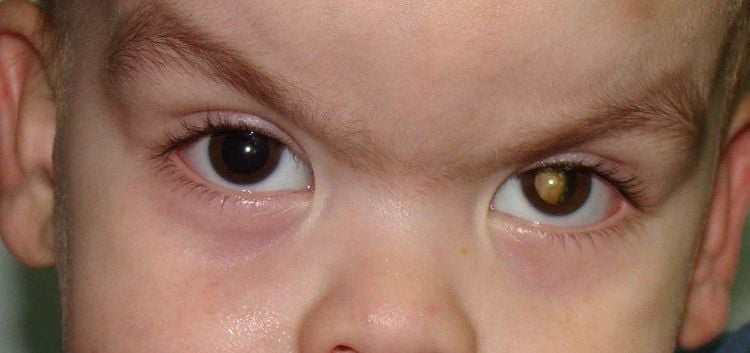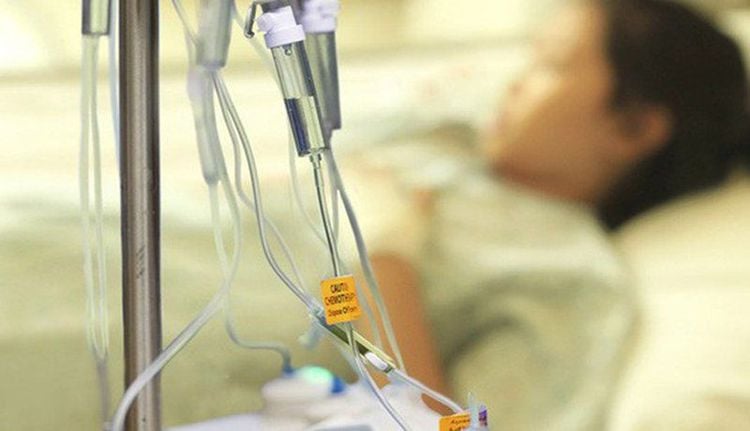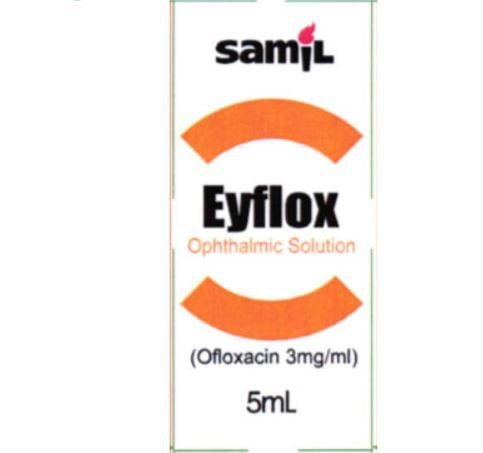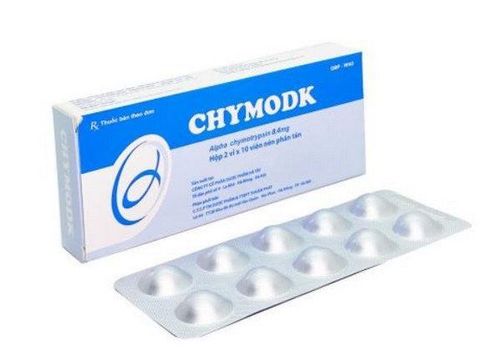This is an automatically translated article.
The article was written by Dr. Dr. Phung Tuyet Lan - Head of Unit - Pediatric Inpatient 3, Children's Center of Vinmec Times City International Hospital.Retinoblastoma also known as retinoblastoma is a malignant eye disease seen in young children. This is a dangerous disease that not only destroys the visual function of the eye but can also be life-threatening.
1. Symptoms of retinoblastoma
Retinoblastoma (UNBVM) is the most common intraocular malignancy in children, accounting for 10-15% of cancers in children under 1 year of age. The typical symptom of the disease is white spot of the pupil (leukocoria) in children under 2 years of age. The disease, if left untreated, can lead to death, but with current treatments, survival rates can reach over 95% in developed countries.To get the best results in the treatment of retinoblastoma requires multi-specialty coordination: Pediatric ophthalmologist, pediatric oncologist, radiologist, interventional radiologist, doctor neurosurgeon, genetic consultant...
2. Classification of retinoblastoma
Depending on the size and signs of local spread, intraocular UNBVM is classified as follows:
Group A (very low risk): U ≤ 3mm, > 3mm from the macula and > 1.5 mm from the optic disc Group B (low risk): Tumor in the retina that is not in group A. Subretinal fluid halo ≤ 3 mm Group C (moderate risk): Tumor localized to the retina and localized subretinal spreading or Vitreous Group D (high risk): Tumor diffuse in the retina and/or disseminated subretinal or intravitreal Group E (very high risk): Large tumor that destroys structure and function of the retina eye (large tumor > 1⁄2 of the eyeball, tumor in the anterior hemisphere, intraocular hemorrhage, tumor necrosis, orbital cellulitis...) Bilateral tumor: Tumor with both eyes Trilateral tumor ): Unilateral or bilateral retinoblastoma combined with intracranial tumor of the same nature. Metastatic tumor: Invasion of eye socket, cervical lymph nodes, or distant metastasis to bone, bone marrow, central nervous system.

3. Access to treatment of retinoblastoma
Treatment goals set: Preserve life, preserve vision as much as possible, detect early complications, especially secondary cancers. Treatments include systemic therapy (chemotherapy) and local treatment (cryofreeze, laser, brachytherapy with I125, ophthalmic chemoradiotherapy, intraocular chemotherapy, and ophthalmic surgery). bridge). The choice of treatment method depends on the size, location, number of tumors, the presence or absence of subretinal or vitreous involvement, the patient's age, the prognosis of vision preservation... Risk group Low-grade tumors (peripheral group A and B tumors in one or both eyes) can be treated locally with cryo-coagulation and laser techniques. Some small but centrally located tumors near the macula will be treated with systemic chemotherapy before using topical treatments to avoid vision damage. Moderate and high risk groups (groups C and D): Group C tumors and many patients with group D are indicated for intra-arterial chemotherapy (IAC), which can be combined with systemic chemicals. Some group D diseases with diffuse large tumors will have indications for ophthalmic removal. Small patients less than 3 months old may be prescribed systemic chemotherapy while waiting for intravenous chemotherapy. Very high risk group (group E): Group E patients will be indicated for ophthalmectomy, adjuvant chemotherapy or orbital radiation therapy after surgery, depending on the pathological results with risk factors. or not. Bilateral retinoblastoma : A maximally conservative approach, a combination of systemic chemotherapy and local treatments Trilateral retinoblastoma : Multimodal treatment using High dose chemotherapy with autologous hematopoietic stem cell transplantation, neurosurgery and ophthalmology, local radiotherapy. Metastatic retinoblastoma: Multimodal treatment using high-dose chemotherapy with autologous hematopoietic stem cell transplantation, ophthalmic surgery, and radiation therapy. Recurrence: Local recurrence can be continued with laser therapy, cryotherapy, brachytherapy, ophthalmic chemoradiation, intraocular chemotherapy, systemic chemotherapy, in some cases failed indication to remove the eyeball.
4. Treatments for retinoblastoma
4.1 Systemic chemotherapy UNBVM is sensitive to many chemicals, appointing neo-adjuvant chemotherapy with the aim of reducing tumor size to facilitate effective local treatment or safe ophthalmic surgery . Chemicals commonly used: carboplatin, cisplatine, vincristine, etoposide, topotecan, doxorubicin, ifosphamide. Systemic chemotherapy increases the rate of ocular and visual acuity preservation. Systemic chemotherapy is indicated after ophthalmic surgery for patients with pathologic risk factors to reduce the risk of recurrence as well as in metastatic stage patients with the goal of increasing survival. .

4.2 Topical Treatment Ocular Artery Chemotherapy : This method would be to reduce the side effects of systemic chemotherapy and allow for the delivery of a high dose of chemotherapy directly to the tumor. The procedure is performed under general anesthesia, a catheter will be inserted from the inguinal artery up to the ophthalmic artery, followed by chemotherapy (Melphalan, Topotecan, Carboplatin) will be infused through the catheter for 30 minutes. The main complications recorded were periorbital edema, retinal detachment, vitreous hemorrhage, eyelid drooping, vascular damage that can lead to choroid-retinal atrophy... Intraocular chemical injection: Used in combination with ophthalmic chemotherapy or systemic chemotherapy in cases of recurrent/unresponsive vitreous dispersion, allowing to reduce the rate of orbital radiotherapy. Cryofreezing/thermal laser: Used to treat small tumors (<6 mm in diameter, < 3 mm in thickness), possibly in combination with systemic chemotherapy. Possible complications: retinal detachment, retinal occlusion, vitreous hemorrhage, retinal pull. Brachytherapy:: Using a disc with I-125 placed at the sclera at the site of the tumor, radiation dose of 40-45 Gy. Some limitations: not effective for large, multi-tumor, posterior pole tumors, disseminated in vitreous; complex implementation techniques; complications (cataracts, retinopathy, optic nerve damage, secondary cancers). Brachytherapy is often indicated when other local treatments have failed. Eyeball removal surgery: Usually indicated for eyes in group E and some eyes in group D with large tumors and inability to preserve vision; tumors causing protrusion, glaucoma and orbital cellulitis; tumors with optic nerve invasion; Local treatment of tumors has failed and is unlikely to preserve vision. During surgery, the child will be placed in the orbit and then about 6 weeks after the orbital connective tissue regenerates, the prosthetic eye will be fitted. External radiation therapy: Currently rarely used due to other effective local treatments as well as the risk of secondary carcinogenesis, especially in patients with RB1 gene mutations.
5. Result
Results of treatment for retinoblastoma vary by country, with survival rates ranging from 30% in developing countries to over 90% in developed countries. Patients with metastatic disease have a poor prognosis, especially with central nervous system metastases. The prognosis of patients with hematopoietic metastases is improved with high-dose chemotherapy plus autologous hematopoietic stem cell transplantation.
The outcome of vision-preserving treatment depends on the stage of the tumor as well as the treatments used. According to a number of studies, the conservative treatment results of the IAC method of ophthalmic arterial chemical injection reached 66%, of which the rate of patients in groups A, B, C achieved 86% compared with 57% in the group A, B and C. D, E.
End-of-treatment patients are followed up with pediatric ophthalmologists and oncologists for early detection of recurrence and treatment-related late adverse events (renal function, hearing, secondary cancer).
Vinmec International General Hospital is one of the hospitals that not only ensures professional quality with a team of leading medical doctors, modern equipment and technology, but also stands out for its examination and consultation services. comprehensive and professional medical consultation and treatment; civilized, polite, safe and sterile medical examination and treatment space.
For detailed information, please contact the hospitals and clinics of Vinmec health system nationwide.
Please dial HOTLINE for more information or register for an appointment HERE. Download MyVinmec app to make appointments faster and to manage your bookings easily.














